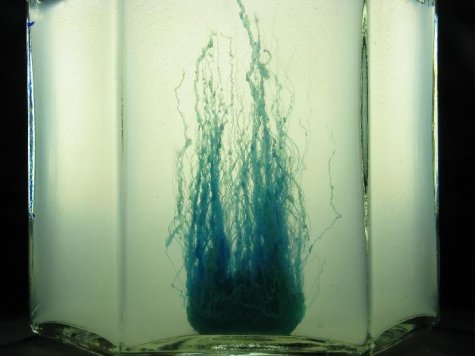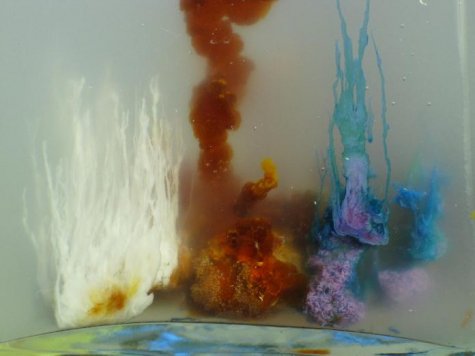A strange garden
Text: Jaak Kikas, UT Institute of Physics
Photos: Jaak Kikas and Wikimedia
Translation: Liis from forum
“Chemical garden”: copper silicate “plants” in a water-glass solution.
In the previous instalment it was stated that to obtain quartz glass very high temperatures are necessary (crystalline quartz melts at a temperature of 1700 °C). Naturally occurring quarts glass has thus been formed in exceptional circumstances (volcano eruptions, the fall of giant meteorites, lightning striking sand). If this had remained so, glass would hardly have found such widespread use as it has today.
But man is inventive. Exactly how he arrived at this will probably remain hidden forever, but about 5500 years ago it was discovered in Egypt that if certain substances (soda, potash) are added to quartz sand, it will melt at substantially lower temperatures, and when the molten mass cools, it becomes a hard, transparent material that we today know as glass. In addition to the mentioned substances, lime (or limestone) is added to the mixture for producing glass.
But if this last ingredient is not added? Glass will form then too, only this glass … dissolves in water. And the solution is called water-glass. Obviously, for most of the common uses of glass (window glass, glass vessels) such glass will not do at all. But it isn’t quite without its uses. If water-glass is spread on a mineral surface (plaster) it reacts with the mineral base and the carbon dioxide in air, forming a weather-resistant layer which at the same time is permeable to water vapour. This process is utilised in the silicate paint coatings. And once there was a glue (older readers may remember it) called office glue – this too was made of water-glass. It wasn’t a particularly good glue – it spoiled the paper and tended to become brittle on aging, but for a limited time it filled its purpose.
Now, however – to the garden! The chemical garden is a quite impressive chemical experiment that is not complicated to carry out for anyone who is interested. A jar of water-glass from a building materials store is needed – the more transparent the better. It should preferably be diluted with 5-6 times its volume of water. Further, some metal salts are needed, of metals whose silicates are not soluble in water. Table salt (sodium chloride) will not do, but copper sulphate, or copper vitriol, (CuSO4·5H2O), used in gardens, and iron(III)chloride, used for pickling electronic printed circuits, are suitable, and so is calcium chloride. Take a few grains of the salts (as solids, not dissolved) and drop them into the diluted water-glass.
But man is inventive. Exactly how he arrived at this will probably remain hidden forever, but about 5500 years ago it was discovered in Egypt that if certain substances (soda, potash) are added to quartz sand, it will melt at substantially lower temperatures, and when the molten mass cools, it becomes a hard, transparent material that we today know as glass. In addition to the mentioned substances, lime (or limestone) is added to the mixture for producing glass.
But if this last ingredient is not added? Glass will form then too, only this glass … dissolves in water. And the solution is called water-glass. Obviously, for most of the common uses of glass (window glass, glass vessels) such glass will not do at all. But it isn’t quite without its uses. If water-glass is spread on a mineral surface (plaster) it reacts with the mineral base and the carbon dioxide in air, forming a weather-resistant layer which at the same time is permeable to water vapour. This process is utilised in the silicate paint coatings. And once there was a glue (older readers may remember it) called office glue – this too was made of water-glass. It wasn’t a particularly good glue – it spoiled the paper and tended to become brittle on aging, but for a limited time it filled its purpose.
Now, however – to the garden! The chemical garden is a quite impressive chemical experiment that is not complicated to carry out for anyone who is interested. A jar of water-glass from a building materials store is needed – the more transparent the better. It should preferably be diluted with 5-6 times its volume of water. Further, some metal salts are needed, of metals whose silicates are not soluble in water. Table salt (sodium chloride) will not do, but copper sulphate, or copper vitriol, (CuSO4·5H2O), used in gardens, and iron(III)chloride, used for pickling electronic printed circuits, are suitable, and so is calcium chloride. Take a few grains of the salts (as solids, not dissolved) and drop them into the diluted water-glass.
A varied garden: white “growths” are from calcium chloride (CaCl2), blue from cobalt chloride (CoCl2) and the thick reddish-brown “stalk” in the middle is from iron(III)chloride.
 But let a great author tell us about it:
But let a great author tell us about it:“The vessel of crystallisation was three-quarters full of slightly muddy water - that is, dilute water-glass - and from the sandy bottom there strove upwards a grotesque little landscape of variously coloured growths: a confused vegetation of blue, green, and brown shoots which reminded one of algae, mushrooms, attached polyps, also moss, then mussels, fruit pods, little trees or twigs from trees, here and there of limbs. It was the most remarkable sight I ever saw, and remarkable not so much for its appearance, strange and amazing though that was, as on account of its profoundly melancholy nature. For when Father Leverkühn asked us what we thought of it and we timidly answered him that they might be plants: "No," he replied, "they are not, they only act that way. But do not think the less of them. Precisely because they do, because they try to as hard as they can, they are worthy of all respect."
It turned out that these growths were entirely unorganic in their origin, they existed by virtue of chemicals from the apothecary’s shop, the “Blessed Messengers”. Before pouring the water-glass, Jonathan had sprinkled the sand at the bottom with various crystals, if I mistake not potassium chromate and sulphate of copper. From this sowing, as the result of a physical process called ‘osmotic pressure’ there sprang the pathetic crop for which their producer at once and urgently claimed our sympathy. He showed us that these pathetic imitations of life were light-seeking, heliotropic, as science calls it. He exposed the aquarium to the sunlight, shading three sides against it, and behold, toward that one pane through which the light fell, thither straightaway slanted the whole equivocal kith and kin, mushrooms, phallic polyp-stalks, little trees, algae, half-formed limbs. Indeed, they so yearned after warmth and joy that they actually clung to the pane and stuck fast there.
“And even so they are dead,” said Jonathan, and tears came in his eyes, while Adrian, as of course I saw, was shaken with suppressed laughter. On my part, I must leave it to the reader’s judgment whether that sort of thing is a matter for laughter or tears. But one thing I will say: such weirdnesses are exclusively Nature’s own affair, and particularly of nature arrogantly tempted by man. In the high-minded realms of the humaniora one is safe from such impish phenomena.”
Thomas Mann: “Doctor Faustus”
Translation H C Lowe Porter
Everymans Library, 1992, pp 17-18
The experiment must have fascinated the Nobel Prize winner personally too, or he wouldn’t have given such a long and very thorough account of it in the novel. The final conclusions drawn by the book’s narrator, dr. phil. Serenus Zeitblom, are however the reflections of that character, and should be understood so.
Some explanations may be added. In the aqueous solution the salt grains start to dissolve. But at the same time the dissolved metal ions react with the silicate ions in the water-glass, and around the salt crystals a dense layer (membrane) of very small metal silicate crystals is formed. This layer is still permeable to water molecules – water penetrates the membrane. But the metal ions that are surrounded by a “coat” of water molecules (solvation) cannot get out. As a result the pressure rises within the membrane. It is a phenomenon known as osmosis and also occurs in nature – thanks to osmosis water from the ground can be brought to the tops even of a hundred meter high giant trees. However, at a certain moment the crystalline silicate film can no longer withstand the water pressure inside it, and bursts. A solution rich in metal ions is released into the water-glass, the metal ions at once react with the silicate ions, and the process is repeated. As a result tube- or straw-like hollow formations reminiscent of natural shapes are created, with colours and forms depending on the salts used.
What to say in conclusion? Maybe this, that all is not what it seems to be. But the opposite view may also be considered. Suppose that we at some time in the future discover, somewhere outside Earth (for instance on the “beautiful distant bizarre” planet Gliese 581c), an unusual phenomenon. What might allow us to call it life? Or prevent us from calling it life?
See also Materials world: Water-glass..










